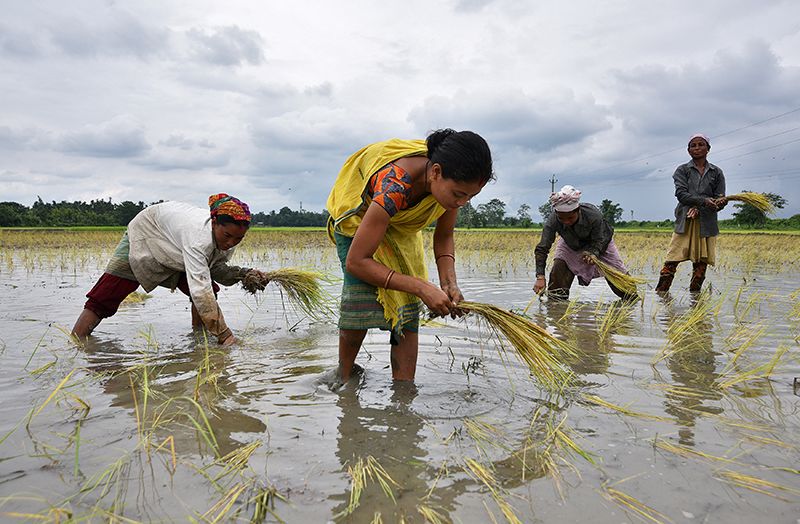

The green revolution created hardier rice that needs more fertilizer than older varieties. Credit: Anuwar Hazarika/Reuters
A gene that enhances plants’ ability to absorb nitrogen could be used to breed high-yield varieties of rice, wheat and other staple crops that would need less fertilizer, researchers report on 15 August in Nature1. That could slash costs for farmers worldwide, and help to limit the environmental damage that occurs when nitrogen-rich water and soil wash from farm fields into rivers and oceans.
The research focused on crops bred during the ‘green revolution’ of the 1960s, a period when agricultural scientists boosted yields by breeding smaller, hardier versions of common crops. Farmers used these alongside improved irrigation methods, strong pesticides and efficient fertilizers. That sent the global harvest of cereal crops soaring from 741 million tonnes in 1961 to 1.62 billion in 1985.
But the latest study shows that there is still room for improvement, says Kathryn Barton, a plant scientist at the Carnegie Institution for Science in Stanford, California. “If you thought that these green-revolution varieties were it — that they’re the end of the line — you’re wrong, because there is more we can do,” she says.
That’s because modern crops have a weakness: they can’t absorb nitrogen as well as traditional crops can, so they need a lot of fertilizer to grow. In 2015 alone, the world’s farmers used roughly 104 million tonnes of nitrogen-rich fertilizer.
That practice is costly for farmers and harmful to the environment, says study co-author Xiangdong Fu, a plant geneticist at the Chinese Academy of Sciences Institute of Genetics and Developmental Biology in Beijing. When nitrogen-rich runoff from farm fields reaches rivers, lakes and oceans, it can feed massive algal blooms that consume oxygen and suffocate aquatic organisms. “That’s why we need to look for new varieties — ones that can produce high yields but with less fertilizer,” Fu says.
To do that, he and his colleagues examined the role of molecules called DELLA proteins that had been identified as the cause of green-revolution plants’ poor nitrogen absorption and short stature. In conventional crops, these proteins are destroyed by hormones that stimulate plant growth. But DELLA proteins flourish in green-revolution crops because the plants are immune to the hormones’ influence, or produce less of them.
Protein vs protein
Fu and his colleagues wanted to find a way to combat the accumulation of DELLA proteins. They began their search by comparing the DNA of 36 varieties of dwarf rice, and looking at the varieties’ ability to absorb nitrogen. The scientists identified two genes that control nitrogen consumption: one that codes for DELLA proteins, and another that codes for a protein called growth-regulating factor 4 (GRF4), which had been thought to increase only grain size and yield. Fu’s team found that GRF4 counteracts the effects of DELLA proteins by encouraging plants to absorb and metabolize nitrogen and carbon to support growth.
Then the researchers bred rice plants to produce a higher concentration of the GRF4 protein. The result was short plants with high yields that required less nitrogen than conventional green-revolution varieties.
The strategy is promising, says Jennifer Volk, an environmental-quality specialist at the University of Delaware in Dover. Farmers use several methods to lessen the environmental harms caused by excess nitrogen and other plant nutrients, such as constructing wetlands whose aquatic plants filter excess nitrogen and phosphorus from water before it drains to streams and rivers, she says. “Going this next step — making the crop more effective and efficient at taking those nutrients up — would tighten that system up even more,” Volk says.
But Anna Michalak, an environmental engineer at the Carnegie Institution who has studied the link between climate change and nutrient runoff in water systems, is more cautious about the implications of the study’s findings. “Whenever something seems like a win–win situation, I immediately think there’s something we haven’t thought of,” she says. “We’re never quite smart enough to anticipate what will happen.”
Nevertheless, Fu and his colleagues are in the middle of preparing a patent, and have already begun plant-breeding programmes in China. Fu anticipates that other parts of the world might see these new breeds of crop in five years. (Nature)

86-10-68597521 (day)
86-10-68597289 (night)

86-10-68511095 (day)
86-10-68512458 (night)

cas_en@cas.cn

52 Sanlihe Rd., Xicheng District,
Beijing, China (100864)

